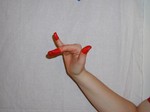Utsanga
Saṃyuta Hasta - Double Hand Gestures
Descriptions and Meanings
9:137
Utsaṅga In this hand the Arala hands are placed in a contrary manner.
9:137:
Its main use is to represent the feeling of touch.
9:138:
Further its employment is to represent anything to be done with excessive effort, acts of anger and indignation, women’s envious acts and squeezing of something.
9:137
Utsaṅga—When the Arāla hands are contrarily placed and are held upturned and bent, the Utsaṅga hand will be the result.
9:137:
It is used to indicate feeling of touch.
9:138:
It is also used to indicate acts of anger and indignation, in pressing of hands similar to women’s acts of jealousy.
26:60
When two Arāla hands are stretched, palm upwards in reverse position and in the Vardhamana way; the combination of hands should be known as Utsanga.
26:60:
It indicates the touch of somebody else.
No verse annotation
Utsanga (embrace): Mrga-Sirsa hands held upon opposite armpits.
No verse annotation:
embrace, modesty, armlet, education of children.

Mṛgašīrsha - No verse annotation

Mṛgašīrsha - No verse annotation
Not included elsewhere
No verse annotation
According to another book: Arala hands held crosswise on the shoulders. The patron deity is Gautama.
No verse annotation:
modesty, embrace, assent, cold, saying “Sadhu”, hiding the breasts, etc.
1:184
Utsanga. If hands showing Mṛgašīrsha are placed on the upper arm of opposite hands the Utsanga hand is made.
1:185:
It is used to denote embrace, displaying armlets and such other ornaments, and coaching of boys.
8:473-474
When two Mṛgašīrsha hastas are held on the opposite arm pits or upper arms, it becomes Utsanga hasta (utsanga - lap; embrace - AKS).
8:473-474:
Utsanga hasta is used to denote the following- embrace, modesty or bashfulness, showing the armlets educating or disciplining the children.
8:475-476
When two Arala hastas are held crosswise on the shoulders, it becomes Utsanga hasta.
8:475-476:
Utsanga hasta is used to denote the following: shyness or modesty, embrace, assent, cold, saying ’sadhu’, hiding the breasts and such other things.
4:1221-1223
Utsaṅga: The two hands which are in Sarpasirsa Hasta are crossed and made to rest on opposite shoulders.
4:1221-1223:
This Hasta is used to depict embracing, anger, cold, bashfulness and women,
Not included elsewhere
7:75
Utsanga: When two arala hastas with opposite sides are joined and kept higher up, it is called utsanga.
7:75:
It shows the separation of lover, and playing ball, etc.
2:184
If arala or sarpaṡīrsha hastas are crossed at the wrists and placed so that the right hand is on the left shoulder and left on the right shoulder, both hands facing the dancer, it is utsaṅga.
2:185:
This is used to press hard, indignation, anger, touching the back (touching secretly), cold, hugging around the neck, jealousy and concealing the breasts.
:71
If the two hands formed into two Arala hastas are held upright (?) and spread out at front, the palms facing upward, it is Utsanga hasta.
:788:
A bed, a blanket, etc. a cotton-padded mattress, ornament, an awning, a big sheet of cloth, etc., used as bed,
:789:
Darkness, milking, pressing, refusal to excuse, touch, taking, extreme jealousy, chariot, grass,
:790:
A fortnight, a month, a year, a day, joy, other measures of time, manifold thing, an eunuch, pressing on enemies, etc. •
:791:
The challenge of wrestler to another, a fight, the cold season, the embrace of the beloved woman, shame—the beautiful Utsanga hasta is indicated in these. Detailed Description of the Subjects of Utsanga Hasta
:794:
The wise should employ Utsanga in all the subjects from ‘milking’ to ‘shame’ according to their shapes.
:792
Utsanga, facing up and revolved in circles,
:792:
means a bed, it also means a cotton-stuffed mattress.
Not included elsewhere
:792
If raised a little and moved in a circle at the front,
:792:
it is ornament.
Not included elsewhere
:793
If Utsanga, facing down, is shown at the front,
:793:
it speaks of an awning. It denotes big sheet of cloth, etc., used as a bed.
Not included elsewhere
:793
If this Utsanga is moved forward,
:793:
it would mean darkness.
Not included elsewhere
7:105
Again, two arāla hastas placed each at the other shoulder, give utsanga
Not included elsewhere
3:447
That hand [gesture] is known as utsanga where the hands face the sides with their backs and are crossed in svastika at the elbow.
Not included elsewhere
3:448-449
Others say that the hands are crossed in svastika touching the shoulders with their forearms. [Yet] another view holds that in utsariga both the hands are either in sarpasirsa or in patāka . Some again suggest arala in place of sarpasirsa or patāka.
3:448-449:
This [gesture] indicates very difficult undertakings, cold, embrace, agreeing to be decorated, bashfulness of a woman etc.

Patāka - 3:325-327
![That is known as arala where the thumb is bent like a bow at first, the palm is curved in the middle and the rest of [the fingers] are half bent touching [each other].](https://lakshmiammanswebsite-live-00aaba1203334-2b2b45f.divio-media.com/filer_public_thumbnails/filer_public/39/61/396110c6-3b76-49b9-b450-f298cef12d5b/sarpasirsa.jpg__150x150_q90_subsampling-2.jpg)
Arāla - 3:355-357
![That [gesture] is known sarpasira when the palm of the patāka hand is curved in the middle.](https://lakshmiammanswebsite-live-00aaba1203334-2b2b45f.divio-media.com/filer_public_thumbnails/filer_public/c6/b6/c6b6321b-86b1-4a66-83eb-acd167b81d8b/img_8039.jpeg__150x150_q90_subsampling-2.jpg)
Sarpaṡīrsha (Ahiphaṇa) - 3:397
Not included elsewhere








